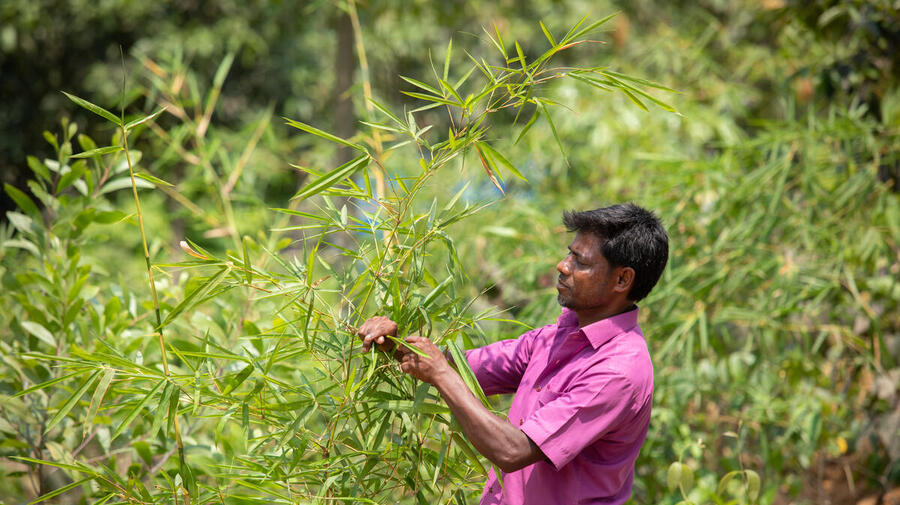
Monsoon Rains Trigger Deadly Flash Floods and Landslides in Cox’s Bazar Refugee Camps
Joint Humanitarian Community Press Release

Photo ©️ Rohingya Refugee Volunteer
Cox’s Bazar, Bangladesh (19 June 2024): UN agencies and the entire humanitarian community are deeply saddened by the tragic deaths of 10 people, including at least seven Rohingya refugees, as heavy monsoon rains battered refugee camps in Bangladesh’s Cox’s Bazar on Tuesday, causing flash floods and landslides.
According to initial reports, some 7,794 refugees have been affected across the 33 camps in Cox’s Bazar, with an estimated 1,191 shelters damaged or destroyed. Critical infrastructure, such as learning centers, health facilities, mosques, latrines, water points and bathing cubicles have also been damaged by the rising water and mudslides.
Since early morning, partners and refugee volunteers have been helping families in affected areas relocate to safer shelters and communal facilities until the waters recede.
UN agencies together with humanitarian partners, in coordination with the Government of Bangladesh, started to provide hot meals, high energy biscuits and post-disaster kits to the refugees, paying special attention to extremely vulnerable individuals, including older people and those living with disabilities.
In the last 24 hours alone, due to the active monsoon, very heavy rainfall (≥ 89 mm) fell on camps in Cox’s Bazar hosting some 930,000 Rohingya refugees. It is expected that there will be more heavy downpours as the monsoon season stretches at least over the next three months. As Bangladesh is currently still recovering from Cyclone Remal which, less than a month ago, displaced a large number of Bangladeshi, heavy rains in the past week has led to widespread inundation across the country.
***
For more information, please contact:
Syed Md Tafhim, ISCG, [email protected] , +8801850018235
Shari Yasmin Nijman; UNHCR; [email protected]; +880 1894-802700
Tarek Mahmud, IOM; [email protected]; +880 1752-380240
ভারীবর্ষনে কক্সবাজারের শরণার্থী শিবিরে ভয়াবহ আকস্মিক বন্যা ও ভূমিধ্বস
কক্সবাজার, বাংলাদেশ (১৯ জুন ২০২৪): গত মঙ্গলবার বাংলাদেশের কক্সবাজারে ভারী মৌসুমী বৃষ্টিপাতের ফলে আকস্মিক বন্যা ও ভূমিধ্বসে কমপক্ষে সাতজন রোহিঙ্গা শরণার্থীসহ ১০ জনের মর্মান্তিক মৃত্যুর ঘটনায় জাতিসংঘের বিভিন্ন সংস্থা এবং মানবিক সহায়তা প্রদানকারী সংস্থাগুলো গভীরভাবে শোকাহত।
প্রাথমিক প্রতিবেদন অনুযায়ী, কক্সবাজারের ৩৩টি শিবিরে প্রায় ৭ হাজার ৭৯৪ জন শরণার্থী ক্ষতিগ্রস্ত হয়েছেন, যার মধ্যে আনুমানিক ১ হাজার ১৯১টি আশ্রয়ণ ক্ষতিগ্রস্ত বা ধ্বংস হয়েছে। ক্রমবর্ধমান পানি ও ভূমিধসে শিক্ষা কেন্দ্র, স্বাস্থ্যসেবা কেন্দ্র, মসজিদ, ল্যাট্রিন, পানির উৎস এবং গোসলখানার মতো গুরুত্বপূর্ণ অবকাঠামোগুলো ক্ষতিগ্রস্থত হয়েছে।
সকাল থেকে মানবিক সহায়তা প্রদানকারী সংস্থাগুলো এবং শরণার্থী স্বেচ্ছাসেবীরা পানি না কমা পর্যন্ত ক্ষতিগ্রস্থ এলাকার পরিবারগুলিকে নিরাপদ আশ্রয় এবং বিভিন্ন সুবিধাপ্রদানকারী কেন্দ্রগুলোতে স্থানান্তরিত করতে সহায়তা করছেন।
বাংলাদেশ সরকারের সংশ্লিষ্ট কর্তৃপক্ষের সাথে সমন্বয় করে জাতিসংঘের সংস্থাগুলো মানবিক সহায়তা প্রদানকারী সংস্থাগুলোকে সঙ্গে নিয়ে শরণার্থীদের অধিক পুষ্টিসম্পন্ন বিস্কুট ও রান্না করা খাবার, দুর্যোগ পরবর্তী ব্যবহার্য গৃহস্থালী জিনিসপত্র সরবরাহ শুরু করেছে, বয়স্ক ও প্রতিবন্ধীসহ অত্যন্ত ঝুঁকিপূর্ণ ব্যক্তিদের প্রতিও বিশেষ মনোযোগ দেওয়া হচ্ছে।
গত ২৪ ঘণ্টায় অতি ভারী বর্ষণের কারণে ক্যাম্পে ৮৯ মিলিমিটারের বেশি বৃষ্টিপাত রেকর্ড হয়েছে এই ক্যাম্পগুলোতে প্রায় ৯ লাখ ৩০ হাজার রোহিঙ্গা শরণার্থী রয়েছেন। কমপক্ষে আগামী তিন মাস ধরে বর্ষা মৌসুম থাকায় আরও ভারী বৃষ্টিপাতের সম্ভাবনা রয়েছে। এক মাসেরও কম সময়ের মধ্যে ঘূর্ণিঝড় রিমালের আঘাতে বিপুলসংখ্যক বাংলাদেশি বাস্তুচ্যুত হয়েছেনে এবং সে পরিস্থিতি কাটিয়ে উঠার চেষ্টা চলছে। এরই মধ্যে গত এক সপ্তাহে সারাদেশে ব্যাপক বন্যা পরিস্তিতি দেখা দিয়েছে।
***
বিস্তারিত তথ্যের জন্য, যোগাযোগ করুন:
সাইয়্যেদ মোঃ তাফহীম, আইএসসিজি, [email protected] , +88 01850 018 235
শারী ইয়াসমিন নিজমান; ইউএনএইচসিআর; [email protected];
তারেক মাহমুদ, আইওএম; [email protected]; +880 1752-380240


 Caption: More funding is needed for skills training and livelihood projects like one that is supporting refugees and host communities to grow bamboo for building and stabilizing hillsides. © UNHCR/Kamrul Hasan
Caption: More funding is needed for skills training and livelihood projects like one that is supporting refugees and host communities to grow bamboo for building and stabilizing hillsides. © UNHCR/Kamrul Hasan



